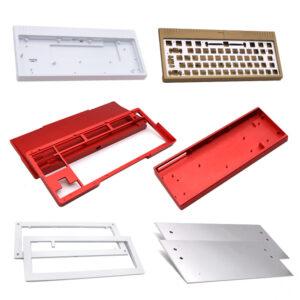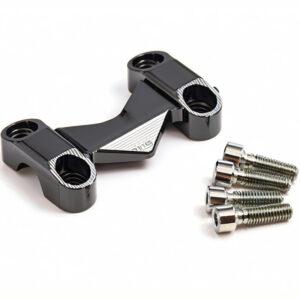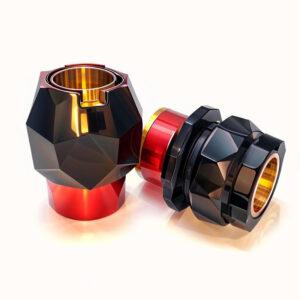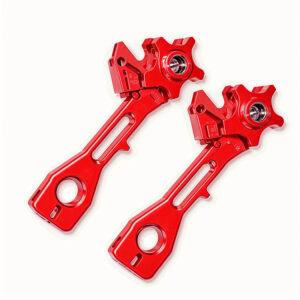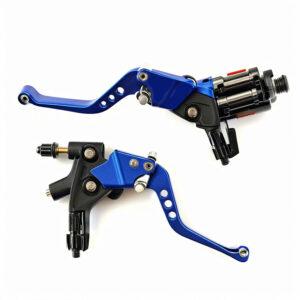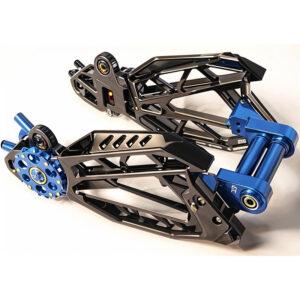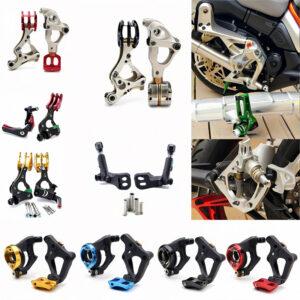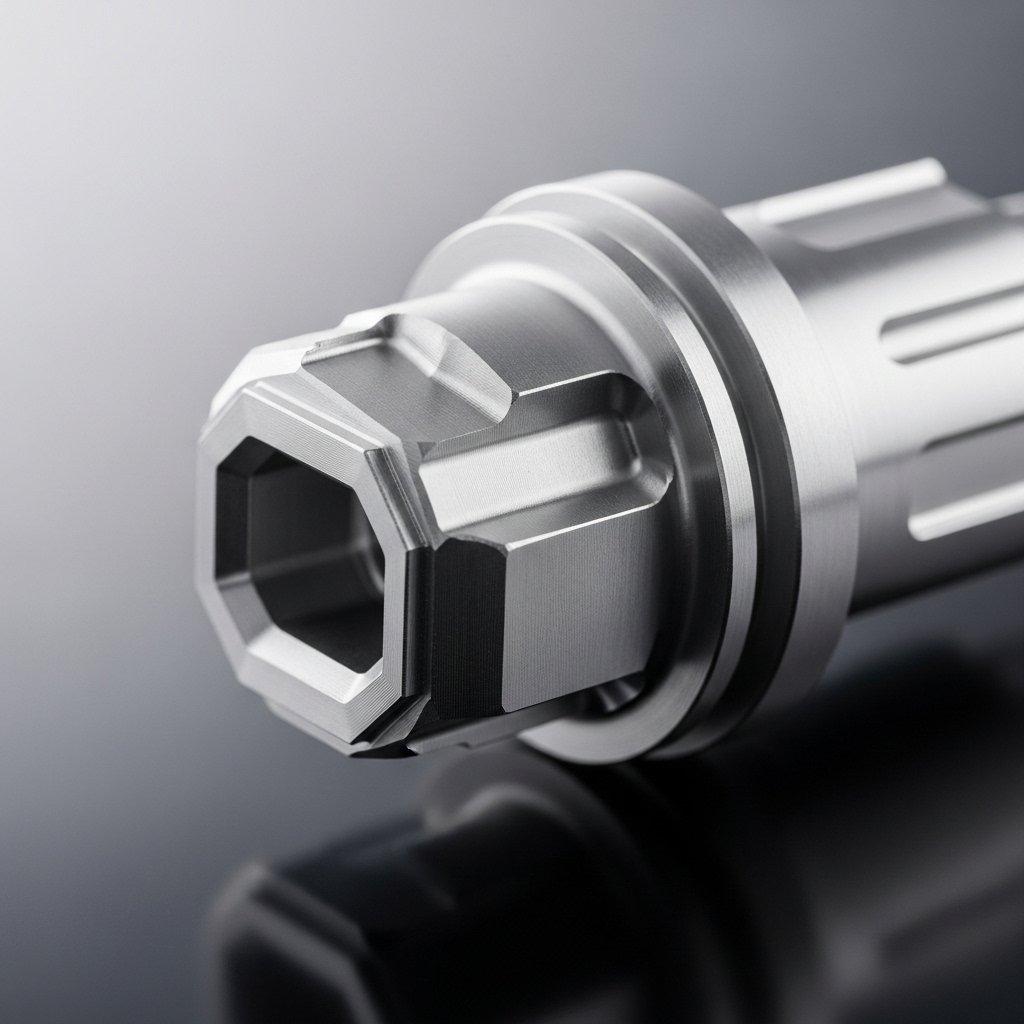High-precision CNC machining of titanium parts
We specialize in solving difficult titanium alloy machining challenges in aerospace, medical devices, precision instruments, etc. With top-of-the-line 5-axis CNC machining centers, we turn your most complex designs into reality with precision, efficiency, and quality.

Titanium machining
1. Evaluation and Optimization (DFM)
Upload the drawing, our engineers will immediately perform manufacturability analysis and provide you with professional cost and efficiency optimization suggestions.
2. Programming and Simulation
Use top CAM software for 5-axis programming, and use full-path simulation to preview the entire processing process to ensure "zero collision" and first-time success.
3. Precision Machining Execution
In the constant temperature workshop, experienced technicians operate top 5-axis machine tools such as DMG MORI to accurately present your design.
4. Full-process Quality Inspection
Use precision instruments such as Hexagon CMM to perform full-process quality inspection from the first piece to the final, and provide a complete report to ensure 100% compliance with the drawing.
CNC parts case
DIY keyboard aluminum shell cnc machining customization
Aluminum parts CNC milling machining
Aluminum Joint CNC Turning Machining
Motorcycle bracket CNC machining customization
Motorcycle brake parts CMC machining customization
Motorcycle parts aluminum plate machining customization
Motorcycle bracket CNC machining customization
Motorcycle modification parts CNC machining customization
- TA1 Titanium
- TA2 Titanium
- TA3 Titanium
- TA4 Titanium
- TC4 Titanium
- TC4ELI Titanium
- TA7 Titanium
- TA9 Titanium
- TA10 Titanium
- TC11 Titanium
- TB5 Titanium
Unveiling TA1 Titanium: A Comprehensive Guide
TA1 titanium stands as the purest grade among commercially pure titanium series. It is an unalloyed material, valued not for high strength, but for its other remarkable set of characteristics that make it indispensable across various high-tech industries.
Appearance and Metallic Nature
Visually, TA1 titanium presents a sleek, silvery-white metallic luster. Its surface is typically smooth and uniform, reflecting its high purity. As a metal, it is surprisingly lightweight, boasting a density far lower than that of steel, yet it maintains a notable level of ductility.
Key Advantages and Inherent Strengths
The most significant advantage of TA1 is its outstanding corrosion resistance. This exceptional TA1 titanium corrosion resistance is particularly effective against seawater and a vast range of chemicals, making it a premier choice for harsh environments. Many industries recognize the benefits of using commercially pure titanium for its longevity and reliability.
Disadvantages and Processing Hurdles
Despite its benefits, TA1 is not without its drawbacks. The primary disadvantage is its relatively low tensile strength compared to titanium alloys. Its high reactivity at elevated temperatures also requires specific handling during processing to prevent contamination and embrittlement.
Navigating the Complexities of Fabrication
The processing of TA1 poses unique challenges. During machining, its low thermal conductivity can lead to heat buildup, causing some of the common problems in titanium milling, such as tool wear and galling. This demands specialized coolants, lower cutting speeds, and rigid machine setups.
Special considerations are essential for joining this material. Adhering to strict TA1 titanium welding specifications, which include using inert shielding gas, is critical to prevent oxygen absorption and ensure a durable, clean weld, free from impurities that could compromise its integrity.
A Look at the Price Point
The cost of this material can be a significant factor in project planning. The TA1 titanium price per kg is considerably higher than that of stainless steel, a reflection of the intensive and energy-consuming Kroll process used for its extraction and purification.
Grade Comparison: TA1 in Context
When people ask what is TA1 grade titanium, it’s best described as the softest and most formable of the commercially pure grades. The primary difference between TA1 and TA2 titanium lies in the allowable oxygen and iron content; TA1 has stricter limits, resulting in higher ductility but lower strength than TA2. A detailed TA1 titanium material properties data sheet will quantify these distinctions.
Diverse Usage Scenarios
The unique properties of TA1 lend it to specific, critical applications. Its biocompatibility makes it suitable for medical implants, while its chemical inertness is vital for the TA1 titanium applications in chemical industry, such as in reactors and piping systems. Furthermore, its lightweight nature is leveraged in CNC machining for aerospace titanium parts, including airframe components where weight reduction is paramount.
Exploring TA2 Titanium: The Industry Workhorse
TA2 titanium is widely recognized as the workhorse of the commercially pure titanium grades. It strikes an exceptional balance between moderate strength, excellent corrosion resistance, and superb formability, making it the most frequently specified grade for a multitude of industrial applications.
Physical Appearance and Metallic Traits
With its bright, silvery-grey metallic finish, TA2 titanium looks clean and modern. Its surface is smooth and non-porous, reflecting its unalloyed nature. This metal is prized for being lightweight yet impressively durable, offering a physical robustness that defies its low density.
Primary Advantages of TA2
The standout feature of TA2 is its remarkable immunity to corrosion, especially in highly oxidizing and mildly reducing environments. This material exhibits a superior TA2 titanium strength to weight ratio, making it stronger than TA1 while retaining excellent ductility. These characteristics are key benefits of commercially pure grade 2 titanium.
Inherent Disadvantages and Limitations
While versatile, TA2 is not suited for high-temperature applications above 400°C (750°F), as it begins to lose its strength. Its tensile strength is also lower than that of titanium alloys, which limits its use in components requiring extreme mechanical performance and high-stress capabilities.
Challenges in Machining and Fabrication
The machinability of grade 2 titanium presents distinct challenges. Its tendency to gall and its low thermal conductivity require sharp tools, high torque at low speeds, and generous amounts of cooling fluid to prevent heat buildup and ensure a clean cut, avoiding common fabrication issues.
Expertise is crucial when working with this metal. Following precise TA2 titanium welding procedures is essential to protect the weld puddle from atmospheric contamination. Improper shielding can introduce impurities like oxygen and nitrogen, leading to a brittle and compromised joint.
Understanding the Cost Factor
When considering this material, the price of TA2 titanium sheet is a significant factor. Its cost is substantially higher than traditional metals like stainless steel due to the complex, energy-intensive processes required for its extraction and production from raw ore.
How TA2 Compares to Other Grades
A frequent question is, what is the difference between Grade 1 and Grade 2 titanium? TA2 contains slightly more oxygen and iron, which makes it stronger than the more ductile TA1. This balanced composition is why it’s often preferred for applications needing a bit more rigidity without sacrificing formability. You can always consult a TA2 titanium material data sheet for precise mechanical values.
Wide-Ranging Industrial Applications
The application scope for TA2 is vast and varied. It is a cornerstone in the chemical processing industry for vessels and heat exchangers. You will also find extensive TA2 titanium use in marine applications for hulls and piping, as well as in architecture and for CNC Machining parts in the automotive sector.
A Deep Dive into TA3 Titanium: The Stronger Pure Grade
TA3, commercially known as Grade 3 titanium, represents a step up in strength within the unalloyed titanium family. It offers a higher mechanical performance than its TA1 and TA2 counterparts while still retaining the hallmark corrosion resistance and relative light weight expected from titanium.
Material Appearance and Metallic Character
Visually, TA3 titanium presents a clean, silvery-gray metallic sheen, indistinguishable from other pure grades. Its character is defined by a superior strength-to-weight ratio when compared to TA1 and TA2, offering a more robust option for components that need to withstand higher loads.
Core Advantages of Using TA3
The primary benefit of this grade is its increased strength. The TA3 titanium mechanical properties make it the strongest of the commercially pure grades that is still readily weldable and formable. This provides engineers with a durable material that also boasts exceptional corrosion and erosion resistance in aggressive media.
Recognizing the Disadvantages
This increased strength comes at the cost of reduced ductility. Compared to TA1 and TA2, TA3 is less formable, which can limit its use in applications requiring complex bending or deep drawing. This trade-off between strength and formability is a key consideration.
The Intricacies of Processing and Fabrication
The higher strength of TA3 makes it more challenging to work with. The machining difficulty of Grade 3 titanium is greater than that of Grade 2, demanding more rigid machine setups, slower cutting speeds, and specialized tooling to manage the increased forces and heat generation during fabrication.
Expertise in CNC Machining is paramount when fabricating components from this material. Precision is key to avoiding work hardening and ensuring tight tolerances are met, especially when creating complex geometries for demanding industrial applications where performance cannot be compromised.
Navigating the Cost of TA3
The price of TA3 titanium bar is typically higher than that of the more common TA2. This cost difference reflects its higher strength profile and the slightly more controlled manufacturing process required to achieve its specific mechanical properties, making it a value-driven choice for specific needs.
TA3 in Comparison to Other Grades
When making a TA2 vs TA3 titanium comparison, the most significant factor is strength; TA3 offers approximately 20-30% more tensile and yield strength. This distinction is clearly outlined in any TA3 titanium material specification sheet, which details its higher allowable oxygen and iron content.
One of the most frequent questions engineers ask is what is grade 3 titanium used for? Its enhanced strength makes it an ideal candidate for applications where TA2 is borderline on mechanical requirements. The benefits of using TA3 titanium plate include its ability to handle higher pressures and stresses.
Primary Usage and Industry Applications
TA3 is frequently employed in aerospace for airframe components, clips, and brackets where moderate strength and weight savings are crucial. Its superior resistance to corrosion also makes it a prime material for chemical processing equipment, pressure vessels, and various TA3 titanium applications in marine environments, where saltwater exposure is relentless.
Understanding TA4 Titanium: The Pinnacle of Pure Strength
TA4, known globally as Grade 4 titanium, stands as the strongest of the four commercially pure (CP) grades. It offers the highest strength and wear resistance within the unalloyed titanium family, carving out a niche for itself in applications where robustness is paramount and the extreme properties of alloys are not required.
Appearance and Fundamental Metallic Nature
Like all pure titanium, TA4 has a lustrous silvery-gray appearance. As a metal, its defining characteristic is its remarkable strength-to-weight ratio, which is superior to the other three CP grades. This makes it an attractive lightweight alternative to high-strength steels and nickel alloys in specific contexts.
The Primary Advantages of TA4
The chief advantage of TA4 is its high strength. The TA4 titanium mechanical properties show significantly higher tensile and yield strength compared to grades 1, 2, and 3. This, combined with its excellent corrosion resistance in oxidizing environments, makes it exceptionally durable.
Key Disadvantages and Limitations
The trade-off for its superior strength is a noticeable reduction in ductility and formability. TA4 is the least cold-formable of the pure titanium grades, which can make manufacturing complex shapes challenging. Its higher hardness also introduces specific fabrication hurdles.
Processing and CNC Machining Challenges
The inherent hardness of this grade means the machinability of Grade 4 titanium is the most difficult among the CP grades. It requires very rigid machine setups, slow speeds, high feed rates, and sharp tooling to overcome its resistance to being cut, making expert knowledge essential.
Successful CNC Machining of TA4 parts demands careful planning to manage heat generation and prevent tool wear. This is especially true when creating high-strength TA4 titanium aerospace components where precision and surface integrity are non-negotiable for safety and performance.
Price and Economic Considerations
When evaluating material costs, the price of TA4 titanium plate is often higher than the more common TA2 (Grade 2). Its higher strength profile requires more controlled processing, and its lower market demand compared to TA2 can also influence its overall cost and availability from suppliers.
A Comparative Look: TA4 vs. Other Grades
A common point of discussion is the TA3 vs TA4 titanium strength comparison; TA4 is measurably stronger due to its higher allowable oxygen content. While still unalloyed, its properties begin to bridge the gap toward some titanium alloys, though it lacks their heat-treatability.
A detailed TA4 titanium material data sheet will confirm its position as the top performer in the pure titanium series. This makes it a go-to choice when an application’s design requirements exceed the capabilities of the other CP grades. The benefits of high purity Grade 4 titanium lie in this specific high-strength, unalloyed niche.
Common Applications and Industrial Uses
Due to its robust nature, TA4 is often utilized for high-performance applications. You will find it in cryogenic vessels, airframe parts, and surgical hardware where high strength and corrosion resistance are critical. Its unique profile also leads to TA4 titanium use in chemical processing for equipment under high pressure and wear stress.
Decoding TC4 Titanium: The Quintessential Alloy
TC4, known globally as Ti-6Al-4V or Grade 5, is the undisputed champion of the titanium world. This alpha-beta alloy, which contains 6% aluminum and 4% vanadium, is by far the most widely used titanium grade, accounting for more than half of all titanium consumption due to its stellar, all-around performance.
Appearance and Fundamental Characteristics
Like other titanium grades, TC4 possesses a modern, silvery-gray metallic appearance. Its defining characteristic is a phenomenal strength-to-weight ratio, providing the high mechanical strength of steel at roughly 40% less weight, a property that makes it exceptionally valuable.
The Overwhelming Advantages of TC4
The primary advantage of TC4 is its versatile combination of high strength, stiffness, and good corrosion resistance, which can be further enhanced through heat treatment. This makes it incredibly adaptable, delivering reliable performance from sub-zero temperatures up to around 400°C (750°F).
Inherent Disadvantages and Limitations
Despite its widespread use, TC4 is not without its drawbacks. It exhibits relatively poor cold formability compared to commercially pure grades, making complex bending or shaping difficult without hot working. It is also more challenging to weld than unalloyed titanium.
Navigating the Complexities of Machining
The machinability of Ti-6Al-4V is notoriously difficult. Its high strength, low thermal conductivity, and chemical reactivity with cutting tools demand rigid machines, low cutting speeds, high feed rates, and copious amounts of specialized coolant to manage heat and prevent tool failure.
Expertise in CNC Machining is critical for achieving tight tolerances on TC4 components. Mastering the best feeds and speeds for milling titanium is essential for an efficient process that avoids work hardening and maintains the integrity of the finished part, a common challenge for machinists.
A Look at the Price Point
The TC4 titanium price per kg is significantly higher than for both commercially pure titanium and conventional metals like stainless steel or aluminum. This premium cost is driven by the complex Kroll process, the inclusion of expensive alloying elements like vanadium, and its difficult fabrication.
How TC4 Compares to Other Metals
When considering TC4 vs 6061 aluminum strength, TC4 is vastly superior in both strength and temperature resistance, though aluminum is lighter and cheaper. A detailed TC4 titanium material properties PDF will show it outperforming most other engineering metals on a strength-to-weight basis.
The benefits of using titanium Grade 5 are most apparent when high strength and low weight are critical design factors. This is why it has become a benchmark material against which many other high-performance alloys are measured.
Widespread Use Across Demanding Industries
TC4’s unmatched property profile makes it a cornerstone of high-tech sectors. Its most prominent use is in aerospace applications of Ti-6Al-4V, such as landing gear and structural airframe parts. It’s also a leading material for high-performance automotive components, marine hardware, and critical TC4 titanium medical grade implants like hip and knee joints.
An Introduction to TC4 ELI: The Medical Grade Standard
TC4 ELI, also known as Ti-6Al-4V ELI or Grade 23, is the high-purity variant of the world’s most common titanium alloy. The “ELI” designation stands for “Extra Low Interstitials,” signifying reduced levels of oxygen, carbon, and nitrogen, which dramatically enhances its performance for critical applications.
Physical Appearance and Metallic Nature
Visually, TC4 ELI is identical to standard TC4, presenting a clean, silvery-gray metallic sheen. Its nature, however, is defined by its superior purity. This refinement results in a metal with exceptional biocompatibility and a significant improvement in ductility and fracture toughness, especially at cryogenic temperatures.
Core Advantages of TC4 ELI Titanium
The primary advantage of this grade is its outstanding damage tolerance. The benefits of Ti-6Al-4V ELI in medical devices are immense, as its high fracture toughness and fatigue strength make it incredibly reliable for long-term implantation within the human body. It offers a superior combination of strength and safety.
Inherent Disadvantages to Consider
While superior in toughness, TC4 ELI has a slightly lower tensile and yield strength compared to its standard TC4 counterpart. This small reduction in strength is a direct trade-off for its enhanced ductility and damage tolerance, a factor engineers must consider during the material selection process.
The Challenges of Machining and Fabrication
The machinability of Grade 23 titanium is just as demanding as standard Grade 5. Its inherent characteristics, like low thermal conductivity and high chemical reactivity, require specialized techniques, including low cutting speeds, high feed rates, and effective cooling strategies to prevent premature tool wear.
Expertise in CNC Machining is crucial for producing the intricate geometries required for medical implants. The process must be meticulously controlled to maintain the material’s integrity, ensuring no surface contamination or alpha case formation compromises the final component’s performance and safety.
Understanding the Cost Implications
The price of TC4 ELI titanium bar is notably higher than that of standard TC4 (Grade 5). This increased cost is a direct result of the additional vacuum arc remelting (VAR) processes required to reduce the interstitial elements and achieve its high-purity chemical composition.
Grade Comparison: TC4 ELI vs. Standard TC4
The fundamental difference between Ti-6Al-4V and Ti-6Al-4V ELI lies in the chemistry. The lower oxygen content in TC4 ELI is the key factor that improves its ductility and fracture toughness. This makes it the preferred choice for medical and aerospace applications where catastrophic failure is not an option.
When reviewing a TC4 ELI material properties data sheet, its superiority in fatigue life becomes evident. This enhanced performance is why it is considered a premium material for high-stakes environments. The biocompatibility of TC4 ELI is certified to meet the stringent requirements for surgical implantation.
Primary Applications and Usage Scenarios
The premier application for TC4 ELI is in the medical field. It is the gold standard for TC4 ELI titanium medical grade implants, including orthopedic pins, screws, bone plates, and joint replacements. Its unique properties are also leveraged in high-performance aerospace components and demanding marine hardware where reliability is critical.
Getting to Know TA7 Titanium: The High-Temperature Specialist
TA7, known internationally as Ti-5Al-2.5Sn or Grade 6, is a high-performance alpha titanium alloy. It is specifically engineered for reliable strength and stability at elevated temperatures, setting it apart from more common grades and making it a critical material for demanding, high-heat environments.
Appearance and Fundamental Metallic Nature
Like all titanium alloys, TA7 boasts a bright, silvery-gray metallic luster. Its nature is defined by its single-phase alpha microstructure, which grants it exceptional weldability and superior creep resistance—the ability to resist deformation under long-term exposure to high levels of heat and stress.
Core Advantages of TA7 Titanium
The primary advantage of this alloy is its excellent performance at high temperatures, maintaining its strength up to 480°C (900°F). The benefits of Ti-5Al-2.5Sn in aerospace are directly tied to this high service temperature and its inherent resistance to oxidation, which ensures structural integrity in harsh engine environments.
Inherent Disadvantages and Limitations
While strong at high temperatures, TA7 has lower tensile strength at room temperature compared to popular alpha-beta alloys like TC4 (Ti-6Al-4V). Furthermore, as an alpha alloy, it cannot be strengthened by heat treatment, which limits its peak mechanical properties.
Navigating the Difficulties of Fabrication
The machinability of TA7 titanium alloy presents a moderate to high level of difficulty. Its strong, tough nature requires rigid machine setups, sharp tooling, and carefully controlled parameters to overcome its tendency to gall and generate heat, which can cause premature tool wear.
Expertise in CNC Machining is essential when working with this alloy to achieve the precise geometries needed for aerospace and industrial parts. The challenges of milling alpha titanium alloys include managing their unique chip formation and avoiding surface contamination to maintain the material’s superior properties.
Understanding the Cost Factor
The price of Ti-5Al-2.5Sn plate is typically in the premium range for titanium alloys. Its specialized composition, including tin as a solid-solution strengthener, and its application in lower-volume, high-performance sectors contribute to a higher cost compared to more mainstream grades.
TA7 in Comparison to Other Titanium Grades
When making a Ti-5Al-2.5Sn vs Ti-6Al-4V comparison, the key differentiator is the intended service environment. TA7 excels in high-temperature creep resistance and weldability, whereas Ti-6Al-4V offers higher room-temperature strength and hardenability. A detailed TA7 titanium material data sheet will clearly outline these performance trade-offs.
The excellent weldability is a significant factor in its selection. The ease of achieving a high-quality, ductile weld makes the welding process for TA7 titanium much more straightforward than for many other high-strength alloys, simplifying the manufacturing of complex assemblies.
Primary Applications and Usage Scenarios
The most prominent applications of Grade 6 titanium are in the aerospace industry. It is frequently used for aircraft engine components such as rings, compressor blades, and discs, as well as for airframe structural members that experience elevated temperatures. Its unique properties also make it suitable for use in certain chemical processing and marine environments.
Meet TA9 Titanium: The Versatile “Half-Alloy”
TA9, known worldwide as Ti-3Al-2.5V or Grade 9, holds a unique position in the titanium family. Often called a “half-alloy,” it bridges the gap between the high strength of complex alloys and the excellent formability of commercially pure grades, creating a versatile, do-it-all material.
Appearance and Fundamental Metallic Nature
With the same sleek, gray metallic luster as other titanium grades, TA9’s true character is in its performance. It is an alpha-beta alloy that offers significantly more strength than pure titanium while retaining an impressive level of ductility and cold workability, a rare and valuable combination.
Core Advantages of TA9 Titanium
The standout feature of TA9 is its superb fabricability. Its ability to be cold-rolled and drawn into seamless tubing makes it unique among alloys. This, combined with good weldability and a useful strength-to-weight ratio, makes it incredibly versatile for manufacturing complex components.
Inherent Disadvantages and Limitations
While strong, the mechanical properties of Ti-3Al-2.5V do not reach the high-tensile strength levels of TC4 (Ti-6Al-4V). This makes it unsuitable for the most demanding, high-stress aerospace applications where maximum strength is the only priority. Its service temperature is also more limited.
Navigating the Challenges of Fabrication
The machining difficulty of Grade 9 titanium is considered moderate, falling somewhere between commercially pure grades and the more challenging TC4. While easier to machine than its high-strength cousins, it still requires sharp tooling, rigid setups, and proper cooling to achieve a fine surface finish.
Expertise in CNC Machining is key to unlocking the full potential of this alloy. For applications like performance bicycle frames or hydraulic lines, precision machining ensures perfect fitment and reliable performance, leveraging the material’s unique blend of strength and formability.
Understanding the Cost Factor
The price of Ti-3Al-2.5V tubing can be a significant investment, often higher than for standard aluminum or steel alternatives. However, its longevity, light weight, and corrosion resistance provide long-term value that justifies the initial cost in high-performance applications.
TA9 in Comparison to Other Grades
When making a Grade 9 vs Grade 5 titanium comparison, Grade 9 offers superior formability and weldability at the expense of lower ultimate strength. This is why it’s the preferred choice for applications requiring complex shapes, especially seamless tubing, which is difficult to produce with Grade 5.
A look at a TA9 titanium material data sheet confirms its “middle ground” status. It provides a significant strength increase over pure titanium without the fabrication headaches of higher-strength alloys, representing an optimized balance for many designers and engineers. The benefits of using Grade 9 titanium lie precisely in this balance.
Primary Applications and Usage Scenarios
The most famous applications of Ti-3Al-2.5V are in high-end bicycle frames and golf club shafts, where its light weight and ride quality are prized. It is also extensively used in TA9 titanium use in aerospace hydraulic lines, as well as for industrial and marine applications where moderate strength and excellent corrosion resistance are required.
Uncovering TA10 Titanium: The Corrosion Resistance Champion
TA10, known globally as Grade 7 or Ti-0.2Pd, is a remarkable member of the commercially pure titanium family. It is essentially Grade 2 titanium with a small but powerful addition of palladium, an enhancement that elevates its corrosion resistance to an extraordinary level, especially in acidic environments.
Appearance and Fundamental Metallic Nature
Visually, TA10 is indistinguishable from commercially pure titanium, possessing a clean, silvery-gray metallic finish. Its fundamental nature is defined by this palladium addition, which acts as a catalyst to significantly improve its performance in reducing acids and chloride-containing media without altering its other mechanical properties.
The Unmatched Advantage of TA10
The single greatest advantage of this grade is its phenomenal corrosion resistance. The benefits of Grade 7 titanium’s palladium content are most evident in its ability to resist crevice corrosion at low temperatures and in high-pH environments, making it the most corrosion-resistant of all titanium alloys.
Inherent Disadvantages and Limitations
The primary drawback of TA10 is its cost. The inclusion of palladium, a precious metal, makes the price of Ti-0.2Pd alloy significantly higher than that of standard commercially pure grades. Its mechanical strength is also identical to Grade 2, meaning it is not suited for high-load structural applications.
Navigating the Challenges of Fabrication
From a fabrication standpoint, the machinability of TA10 titanium is virtually identical to that of Grade 2. It requires sharp tooling, slow speeds, and high feed rates to manage its tendency to gall and to dissipate the heat generated during cutting operations.
Expertise in CNC Machining is vital for creating the precise components used in chemical processing plants. Careful handling is needed to produce complex parts like flanges and valve bodies, ensuring the material’s integrity is maintained for service in the most aggressive chemical environments.
Understanding the Cost-Benefit Analysis
While the initial investment is high, the long-term value proposition is strong. Choosing TA10 titanium for chemical processing equipment is often a cost-effective decision over the lifecycle of the equipment, as its durability drastically reduces downtime, maintenance, and replacement costs.
TA10 in Comparison to Other Grades
When making a Grade 7 vs Grade 2 titanium comparison, the mechanical properties are the same, but the corrosion resistance is worlds apart. TA10 can handle reducing acids where Grade 2 would fail, a critical distinction for specific industrial processes.
A detailed TA10 titanium material data sheet will confirm its physical and mechanical similarity to Grade 2, while highlighting its vastly expanded range of chemical resistance. This makes understanding the service environment the most critical factor when choosing between the two.
Primary Applications and Usage Scenarios
The premier applications of Ti-Grade 7 are found in the chemical and marine industries. It is the material of choice for reactors, piping, valves, and heat exchangers that handle chlorides, sour media, and reducing acids. The corrosion resistance of TA10 in saltwater also makes it ideal for critical marine components where failure is not an option.
An Insight into TA11 Titanium: The High-Performance Workhorse
TA11, also known by its Russian designation BT20, is a high-strength, near-alpha titanium alloy. It is specifically engineered to deliver exceptional performance at elevated temperatures, combining high tensile strength with remarkable creep resistance and thermal stability for demanding aerospace applications.
Appearance and Fundamental Metallic Nature
TA11 titanium presents the same familiar silvery-gray metallic appearance as other high-performance alloys. Its fundamental nature is defined by its complex chemical composition, which includes aluminum, molybdenum, vanadium, and zirconium, creating a robust microstructure capable of withstanding extreme operational stress and heat.
Core Advantages of TA11 Titanium
The key advantage of this alloy is its impressive high-temperature capability. The mechanical properties of TA11 titanium alloy are maintained up to 500°C (932°F), providing excellent long-term structural stability. This makes it a superior choice for components operating in the hot sections of jet engines.
Inherent Disadvantages and Limitations
While exceptional at high temperatures, TA11’s fabrication presents significant challenges. Its complex microstructure and high strength make it more difficult to form and weld compared to commercially pure titanium or more common alloys like TC4 (Ti-6Al-4V).
Navigating the Complexities of Fabrication
The machinability of high-temperature titanium alloys like TA11 is notoriously difficult. Its inherent toughness and low thermal conductivity lead to rapid tool wear and require specialized cutting strategies, including low speeds, high torque, and advanced cooling systems to manage heat effectively.
Mastering the CNC Machining of this material is a highly skilled task. Precision control over every parameter is essential to create intricate parts like engine compressor blades and disks, where dimensional accuracy and surface integrity directly impact flight safety and engine efficiency.
Understanding the Cost Implications
The price of TA11 titanium forgings is firmly in the premium category. The cost is driven by the expensive alloying elements, the complex multi-stage melting process required to achieve its specific chemistry, and the inherent difficulties associated with its fabrication and processing.
TA11 in Comparison to Other Titanium Grades
When making a TA11 vs TC4 titanium comparison, TA11 offers superior strength and creep resistance at elevated temperatures. In contrast, TC4 provides a more balanced profile with better all-around fabricability and lower cost, making it more suitable for general-purpose aerospace applications.
A review of a TA11 titanium material data sheet will confirm its specialization for high-heat environments. The benefits of near-alpha titanium alloys like TA11 are most apparent in applications where long-term thermal stability is the most critical design driver.
Primary Applications and Usage Scenarios
The primary applications of TA11 (BT20) titanium are concentrated in the aerospace and defense sectors. It is a go-to material for manufacturing critical jet engine components, including fan and compressor disks, blades, and casings. Its high strength-to-weight ratio is also leveraged in advanced airframe structures where performance is paramount.
Introducing TB5 Titanium: The Cold-Formable Powerhouse
TB5, known in international circles as Ti-15V-3Cr-3Al-3Sn (Ti-15-3-3-3), is a premier metastable beta titanium alloy. It is celebrated for its unique combination of properties, most notably its excellent cold formability in the solution-treated condition and its ability to achieve very high strength after a simple aging heat treatment.
Appearance and Fundamental Metallic Nature
In its treated state, TB5 titanium has the same gray, metallic appearance as other high-tech alloys. Its fundamental nature is defined by its all-beta microstructure in the solution-treated condition, which makes it exceptionally ductile and easy to form into complex shapes at room temperature—a rare trait for a high-strength titanium alloy.
Core Advantages of TB5 Titanium
The standout advantage of this alloy is its superb cold workability. The benefits of beta titanium alloy TB5 lie in its ability to be bent, stamped, and drawn into intricate parts without the need for hot forming. After fabrication, it can be age-hardened to strength levels comparable to or exceeding those of TC4 (Ti-6Al-4V).
Inherent Disadvantages and Limitations
Despite its strengths, TB5 has a higher density than many other titanium alloys, which can be a drawback in weight-critical applications. Additionally, its properties are entirely dependent on proper heat treatment; in its formable, unaged state, its strength is relatively low.
Navigating the Complexities of Fabrication
The machining challenges of Ti-15-3-3-3 are significant. In its high-strength aged condition, it is very tough and abrasive, while in its soft, solution-treated state, it can be gummy and prone to galling. Both conditions demand specialized approaches to achieve good results.
Proficiency in CNC Machining is essential to properly fabricate TB5 components. Machinists must use rigid setups, optimized cutting tools, and specific parameters to manage its unique properties, particularly when creating high-strength fasteners or complex structural brackets from aged material.
Understanding the Cost Implications
The price of TB5 titanium sheet is in the upper tier of aerospace materials. The high cost is driven by its complex chemical composition, which includes expensive elements like Vanadium, and the precision multi-step processing and heat treatments required to develop its final high-performance properties.
TB5 in Comparison to Other Titanium Grades
When making a TB5 vs TC4 titanium (Ti-6Al-4V) comparison, TB5 offers vastly superior cold formability. While TC4 has a better strength-to-weight ratio and higher service temperature, TB5 is the clear choice for producing complex sheet metal parts that require high final strength without hot forming.
A detailed TB5 titanium alloy material data sheet will showcase its impressive post-aging strength and elongation properties. This unique profile solidifies its reputation as a specialty material for solving specific manufacturing challenges. The heat treatment process for Ti-15V-3Cr-3Al-3Sn is a critical step that unlocks its full potential.
Primary Applications and Usage Scenarios
The most prominent applications of TB5 titanium are found in the aerospace industry. It is widely used to produce high-strength sheet metal components, such as fuselage and wing structures, clips, and brackets. Its high strength also makes it an excellent material for manufacturing specialized, high-performance fasteners and springs.

